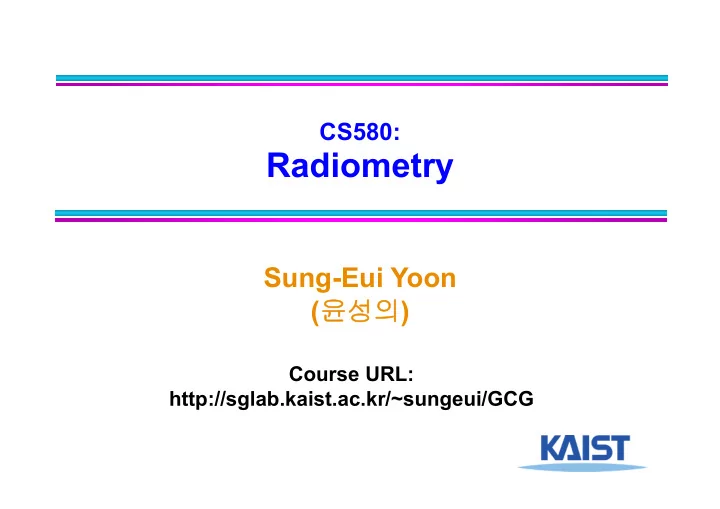

CS580: Radiometry Sung-Eui Yoon ( 윤성의 ) Course URL: http://sglab.kaist.ac.kr/~sungeui/GCG
Class Objectives ● Know terms of: ● Hemispherical coordinates and integration ● Various radiometric quantities (e.g., radiance) ● Basic material function, BRDF 2
Announcements ● Final project ● Make a team of two ● Think about which paper you want to implement ● Present a paper related to it ● Scope of papers ● Papers since the year of 2008 3
Motivation Eye ??? 4
Light and Material Interactions ● Physics of light ● Radiometry ● Material properties From kavita’s slides ● Rendering equation 5
Models of Light ● Quantum optics ● Fundamental model of the light ● Explain the dual wave-particle nature of light ● Wave model ● Simplified quantum optics ● Explains diffraction, interference, and polarization ● Geometric optics ● Most commonly used model in CG ● Size of objects >> wavelength of light ● Light is emitted, reflected, and transmitted 6
Radiometry ● Measurement of light energy ● Critical component for photo-realistic rendering ● Light energy flows through space ● Varies with time, position, and direction ● Radiometric quantities ● Densities of energy at particular places in time, space, and direction ● Photometry ● Quantify the perception of light energy 7
Hemispheres ● Hemisphere ● Two-dimensional surfaces ● Direction ● Point on (unit) sphere From kavita’s slides 8
Solid Angles 2D 3D Full circle Full sphere = 2pi radians = 4pi steradians 9
Hemispherical Coordinates ● Direction, ● Point on (unit) sphere From kavita’s slides 10
Hemispherical Coordinates ● Differential solid angle 11
Hemispherical Integration ● Area of hemispehre: 12
Energy ● Symbol: Q ● # of photons in this context ● Unit: Joules From Steve Marschner’s talk 13
Power (or Flux) ● Symbol, P or Φ ● Total amount of energy through a surface per unit time, dQ/dt ● Radiant flux in this context ● Unit: Watts (=Joules / sec.) ● Other quantities are derivatives of P ● Example ● A light source emits 50 watts of radiant power ● 20 watts of radiant power is incident on a table 14
Irradiance ● Incident radiant power per unit area (dP/dA) ● Area density of power ● Symbol: E, unit: W/ m 2 ● Area power density existing a surface is called radiance exitance (M) or radiosity (B) ● For example ● A light source emitting 100 W of area 0.1 m 2 ● Its radiant exitance is 1000 W/ m 2 15
Irradiance Example ● Uniform point source illuminates a small surface dA from a distance r ● Power P is uniformly spread over the area of the sphere 16
Irradiance Example ● Uniform point source illuminates a small surface dA from a distance r ● Power P is uniformly spread over the area of the sphere θ 17
Radiance ● Radiant power at x in direction θ : 5D function ● L x ( ) ● Per unit area ● Per unit solid angle ● Important quantity for rendering 18
Radiance ● Radiant power at x in direction θ : 5D function ● L x ( ) ● Per unit area ● Per unit solid angle ● Units: Watt / (m 2 sr) ● Irradiance per unit solid angle ● 2 nd derivative of P ● Most commonly used term 19
Radiance: Projected Area 2 d P d dA cos ● Why per unit projected surface area 20
Properties of Radiance ● Invariant along a straight line (in vacuum) From kavita’s slides 21
Invariance of Radiance We can prove it based on the assumption the conservation of energy. 22
Sensitivity to Radiance ● Responses of sensors (camera, human eye) is proportional to radiance From kavita’s slides ● Pixel values in image proportional to radiance received from that direction 23
Relationships ● Radiance is the fundamental quantity ● Power: ● Radiosity: 24
25
26
27
28
29
30
31
32
Light and Material Interactions ● Physics of light ● Radiometry ● Material properties From kavita’s slides ● Rendering equation 33
Materials Ideal diffuse (Lambertian) Ideal specular Glossy From kavita’s slides 34
Bidirectional Reflectance Distribution Function (BRDF) 35
36
37
38
Homework 1 ● Prove the invaraince 39
Speaking of Radiometry ● “I need to sum all those radiances to compute the irradiance based on hemispherical integration.” ● “Do you have a BRDF model for that copper model? If you give me that model, I can support its visual appearance.” 40
Next Time ● Rendering equation 41
Any Questions? ● Come up with one question on what we have discussed in the class and submit at the end of the class ● 1 for already answered questions ● 2 for typical questions ● 3 for questions with thoughts ● 4 for questions that surprised me 42
Recommend
More recommend